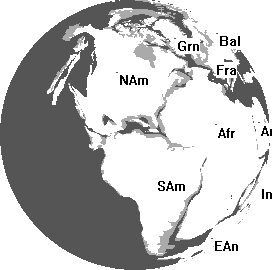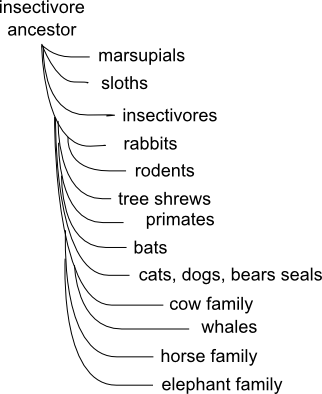|
History of the Universe eBook. 398 pages, 300 illustrations only £5.99
Jurassic Period 200 to 146 myaSummaryThe Jurassic began with a mass extinction event which allowed the dinosaurs to dominate all other groups, hence this was the "Age of Dinosaurs". Pangaea rested over the equator, so many places had tropical climates with green forests. Because of the dominance of dinosaurs, mammals remained small and probably nocturnal. Birds made their first appearance. The period takes its name from the Jura Mountains in Eastern France. Continents 200 mya
Earth 200 mya. Click here for key. Previous image. Next image About 200 mya Pangaea started to break up, and its fragments drifted around. The movement of continents had an effect on the evolution of life. For example Australia and South America were for a long time part of one large island, separated from the other continents. That is why we find animals called marsupials in both these places but nowhere else. While they were drifting, the continents were mostly low lying, worn down by the weather. This is the normal state of the world. Eventually the continents drifted into their present positions. Collisions between these scattered continents have been quite common over the past few million years, making the mountains we find on Earth today. ClimateBecause Pangaea lay across the equator, much of the land was covered by dense tropical forests of conifers, tree ferns and horsetails. But new types of plants were also appearing which would eventually dominate these earlier forms. Jurassic DinosaursFollowing the mass extinction at the end of the Triassic, the warm weather and abundant food, conditions were perfect for divergence of the dinosaurs and the appearance of huge specimens, such as Diplodocus, one of the largest land animals which ever lived.
Diplodocus image courtesy of Dmitry Bogdanov In addition reptiles of all sizes lived in the ocean and some dinosaur relatives even began to conquer the skies. BirdsThe closest living relatives to the dinosaurs are the birds. The first known bird, Archaeopteryx, appeared about 150 mya. Within a few million years they evolved into the birds called Enantiornithes or Ďopposite birds' because of the way their feet bones grew. These lasted for around 70 million years before becoming extinct and being replaced by Ornithurae, the group which includes modern birds, which is believed to have appeared around 65 mya, at the same time that the dinosaurs became extinct. The animal shown here is a newly discovered Chinese dinosaur Caudipteryx Zoui. It lived in the Cretaceous period 120 mya. This theropod dinosaur was a speedy, two-legged meat-eater which was no larger than a peacock. What makes it so remarkable are the primitive feathers covering its body. Its short forelimbs could be described as either feathered arms or clawed wings. Although unable to fly, Caudipteryx Zoui seems to lie on an evolutionary track leading directly from dinosaurs to birds.
Image copyright Joe Tucciarone MammalsImprovements in reproduction were happening in the vertebrate world too. Instead of laying their eggs, female mammals kept them inside their bodies while they developed. In this way they protected their young, feeding them and giving them oxygen. The young could develop larger brains and more advanced bodies than any reptile.
After birth the young were looked after by their mothers, who fed them a rich food called milk. Mammals were the only animals able to make this wonderful food. Then began a long period of care and training when the young learnt from their parents. Unlike dinosaurs, who probably needed the Sun's heat to keep them warm, the mammals had fur to keep them warm. They also had a better blood system. Mammals were also far more intelligent than dinosaurs. Even the stupidest mammal is a genius compared to the brightest reptile. Their long development, when they are cared for by their mother, is what lets mammals' brains grow so much more than reptiles'. Mammals first appeared about 200 mya. It is strange that while the mammals had better bodies and brains than the dinosaurs, even so for a long time they were unable to spread. This was probably because most life-styles were already taken by the less advanced but more common dinosaurs. Mammals stayed as small shrew-like insect-eating animals, perhaps only coming out at night.
Simplified family tree of mammals
History of the Universe eBook. 398 pages, 300 illustrations only £5.99 |
eBook only £5.99 398 pages, 300 images  "I find the science fabulous...an extremely useful teaching tool." Professor David Christian. Follow @WykenSeagrave |

The complete history of the Universe -- from the Big Bang to 200 my into the future





